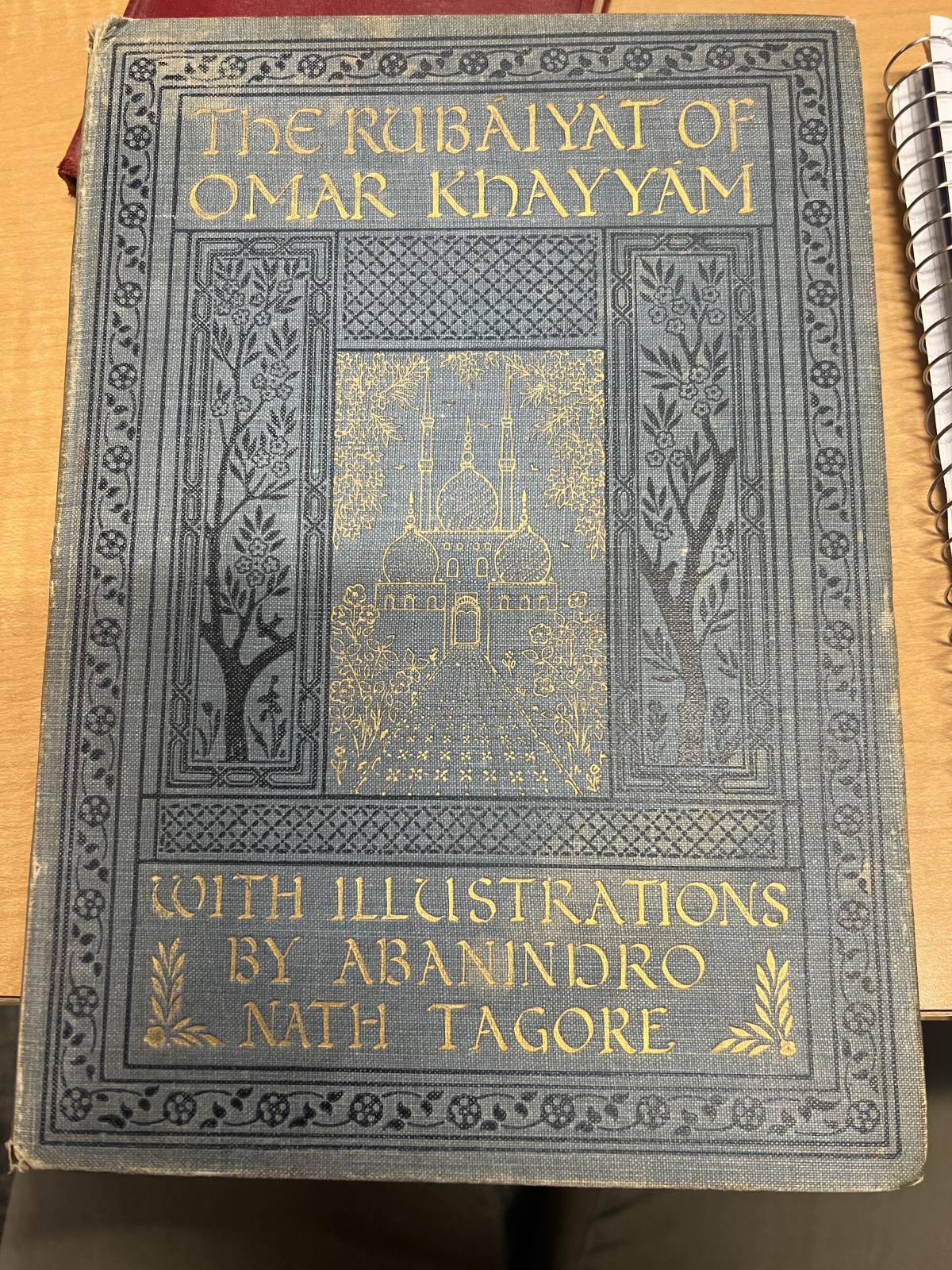Though the Rubáiyát of Omar Khayyám has been printed hundreds of different ways, opening this edition is like breaking open a piece of baked bread. Faded patches in the sewn binding hardcover, whose two-toned blue – the background a muted azure, with intricate trimming and flowering trees detailed in navy thread – betrays years of love and wear (see Figure 1). Yet, the gilded serif font and focal piece – a golden mosque crowded on all sides by leaves and flowers – reflect the edition’s value, which has been preserved since its publishing in the first decade of the 1900s. The book’s invitation is strong: a delightful outside enticing the reader to sit down and consume its warm, welcoming inside; perhaps with a glass of wine.
In the pages between the covers resides the wildly famous 1859 first edition English translation of Omar Khayyám’s Rubáiyát, by Edward Fitzgerald. Though Khayyám was not known as a poet during his time, the opening page labels the edition as The Rubáiyát of Omar Khayyam, The Astronomer Poet of Persia. This particular edition was published by George W. Jacobs & Company in Philadelphia, and is accompanied by illustrations on colored plates by Abanindro Nath Tagore. Tagore was born in 1871 in Bengal, British India, whose goal was to create and teach art that countered the English influence on Indian artists (Cultural India). He created the “Indian Society of Oriental Art,” which would divert from the Western model of art being taught in India, and established the Bengal school of art. Although his art was featured in this edition of the Rubáiyat, most of his works depicted Hindu ideas (Cultural India). There are 63 pages total.
Tagore’s artwork within these pages may have once been bursting with color, from bright yellow garments to vivid pink rosebuds; but the ink is muted, most likely due to time. Nonetheless, the artwork is beautiful, with human subjects either alone and forlorn or enjoying each other’s company. There are hints of gilding – or at least gold-colored ink – in Tagore’s artwork as well. The pages are brittle and acidic, as shown by darkened pages.
Another element, besides the cover, that is very unique in this edition is that there are excerpted quatrains from the Rubáiyát paired with one of Tagore’s illustrations, which break the poem into sections. For example, stanza LXXIII is excerpted on a page of its own, and on the subsequent page is a Tagore illustration of what appears to be a woman and man sitting together in nature, enjoying a drink (see Figure 2). I also find it fascinating that the man is barefoot, which may represent leisure and freedom in this lifestyle of drunkenness and lustfulness Khayyám appraises in the poem.
An additional element that is unique to this edition is a red drop cap – design term for “dropped capital letter” – at the beginning of each stanza (see Figure 3). The red capital letter matches the red used in the roman numerals labeling each quatrain (stanza) as well.
Altogether, this edition of the Rubáiyát of Omar Khayyám is a halfway point in the spectrum of extravagance, reflecting the value and popularity of the poem at the time, while also retaining an air of welcomeness and accessibility to anyone being gifted this book.
Works Cited:
Cultural India. “Abanindranath Tagore Biography - Life History, Paintings & Artwork, Facts.” Biography - Life History, Paintings & Artwork, Facts, https://www.culturalindia.net/indian-art/painters/abanindranath-tagore…;




